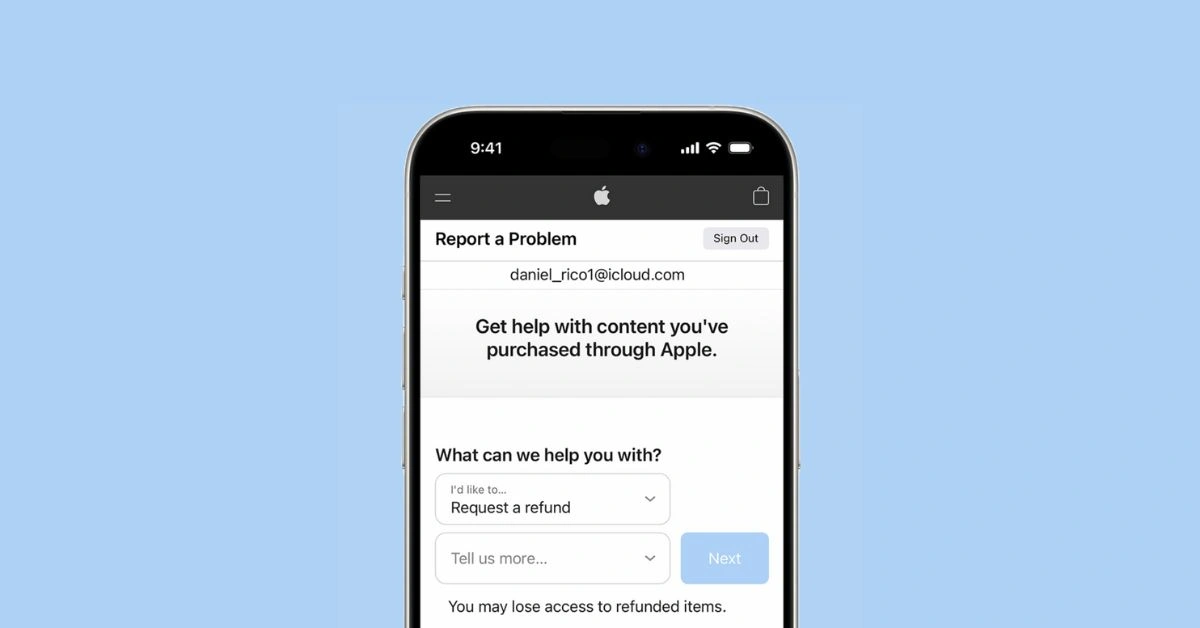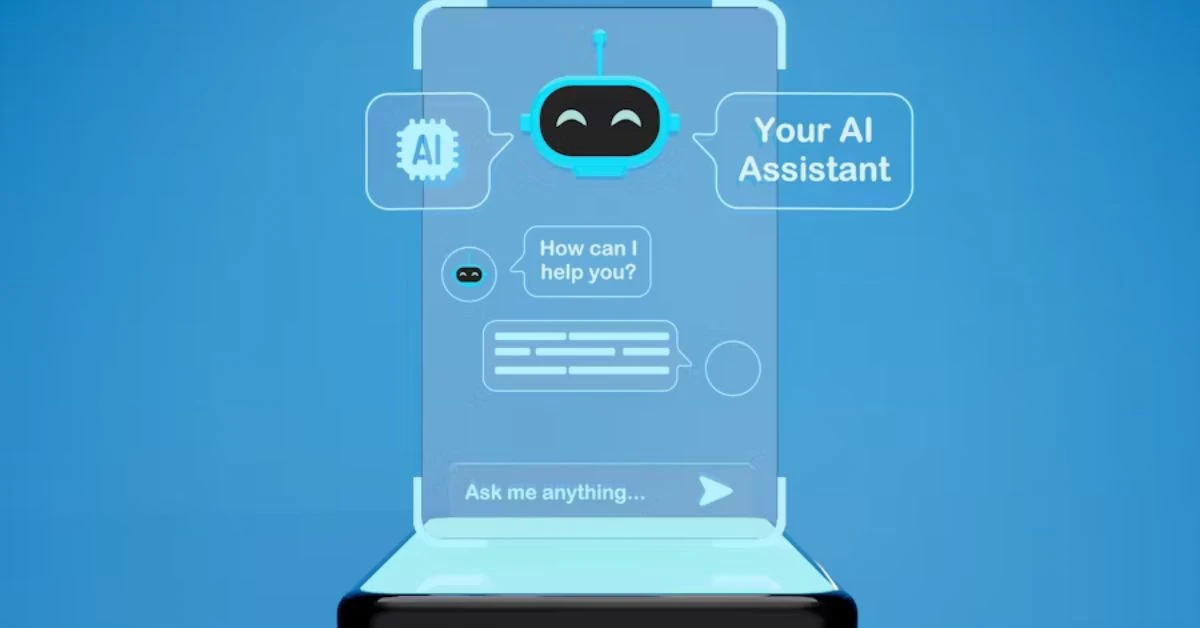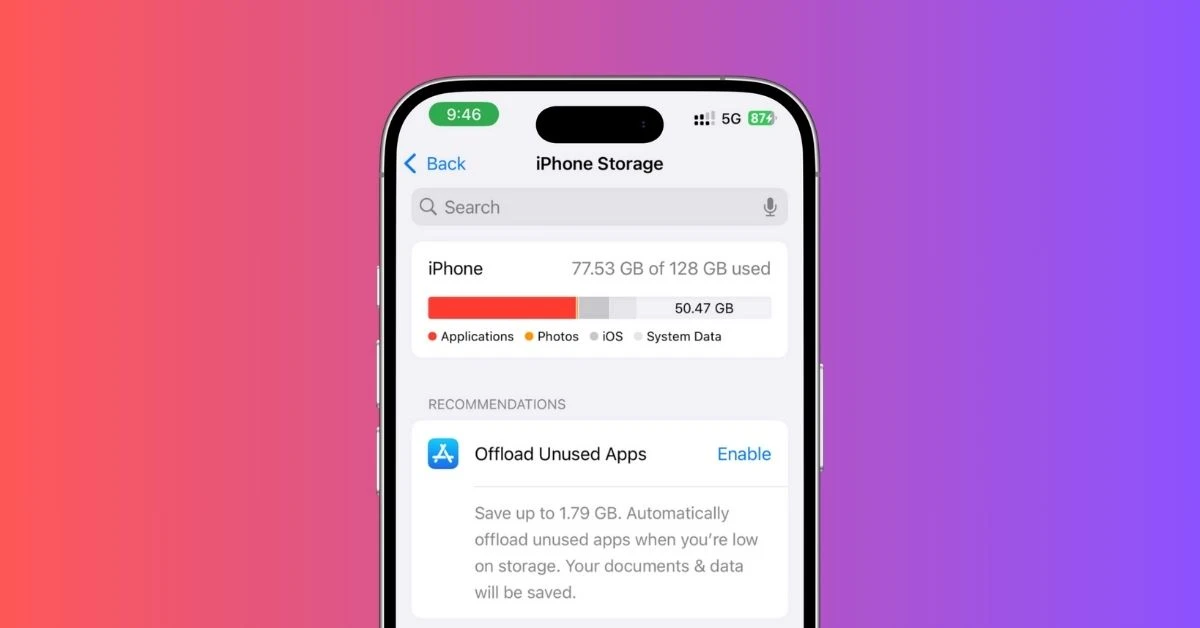How to Use ChatGPT on iPhone Like a Pro in 2025
Want to unlock the real power of ChatGPT on your iPhone?
Most people just open the app, type a few questions, and think that’s it.
But the truth is, ChatGPT can do way more than you probably realize, especially with the latest updates.
In this guide, I’m going to walk you through everything you need to know to use ChatGPT like a pro.
These are not just basic tips but actual real-life use cases, prompt formulas, shortcuts, hidden features, and how to make the most of iPhone + AI combined.
We’re talking:
- How to set it up for peak performance
- Real-world ways people are actually using it
- Prompt templates you can steal and use
- Deep integration with iOS features like Siri, Visual Look Up & Genmoji
- And a sneak peek at what’s coming next from OpenAI + Apple
No fluff. No clickbait.
Just straight-up useful stuff that’ll help you actually do more with the tech you already have in your pocket.
Let’s dive in.
Why ChatGPT on iPhone is a Total Game-Changer
If you’ve only used ChatGPT on your laptop or just fired off a few quick questions in the browser, you’re only scratching the surface of what it can really do.
Once you experience ChatGPT on your iPhone, especially with the latest iOS features, it transforms into something much more than just a chatbot.
It becomes a smart, portable assistant that’s always with you, ready to help anytime, anywhere.
Here’s what makes the iPhone version feel like a whole different level:
1. It’s More Connected Than Ever With iOS
Apple has been slowly but surely opening the doors to smarter integrations.
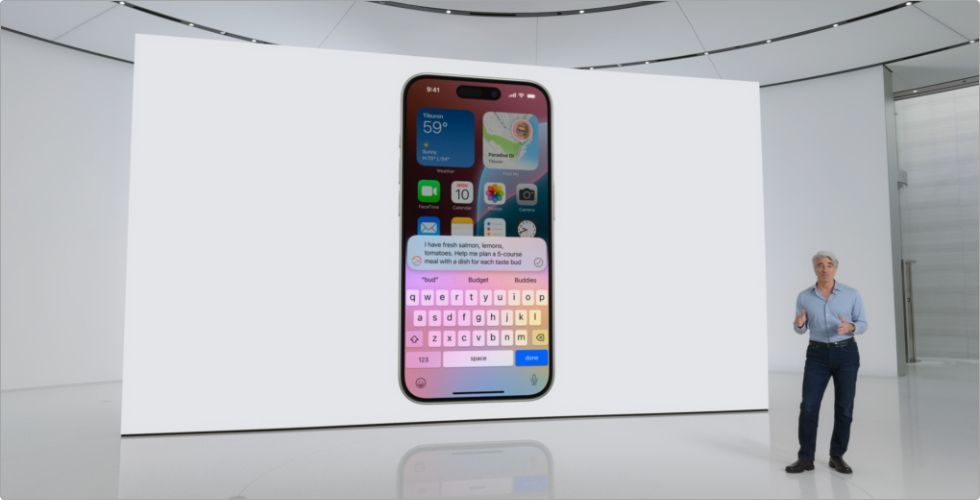
And that benefits ChatGPT in a big way.
Now, on your iPhone:
- You can ask Siri something, and if it hits a wall, Siri can now pass the query to ChatGPT (this works especially well with Shortcuts).
- Features like Live Text (which pulls text from photos) and Visual Look Up (which identifies objects/images) can work hand-in-hand with ChatGPT. For example, snap a photo of a menu in a different language, and ChatGPT can translate or explain the dish instantly.
- The Share Sheet lets you send anything — a webpage, a block of text, or even a file — directly to ChatGPT for deeper understanding or summarization.
- Voice mode feels smooth and natural. Just speak your thoughts, and ChatGPT replies like you’re having a casual chat with a smart, always-on assistant.
These aren’t gimmicks.
They make the whole iPhone experience smarter, more fluid, and, honestly, more helpful.
2. Powered by GPT-4 Turbo
When you use ChatGPT with a Plus subscription on iPhone, you’re tapping into GPT-4 Turbo.
It’s the fastest and most capable version of OpenAI’s language model.
Why does that matter?
- It’s faster than standard GPT-4, meaning responses come quicker, perfect for mobile use.
- It can handle more complex conversations, understand files, generate images, and support longer context with memory.
- It allows you to upload documents, photos, or even voice messages and get meaningful, instant responses.
In short, it’s like upgrading your iPhone with a super-intelligent co-pilot.
Whatever you’re doing — writing, researching, organizing, learning — GPT-4 Turbo boosts it.
3. Built for Real Life, Not Just Typing
Unlike desktop use, the iPhone app is built for everyday moments.
It’s quick, intuitive, and always just a few taps away.
Here’s where it really shines:
- Need to summarize a long email while walking into a meeting? Open the app, paste it in, and get a 2-line summary.
- Got a thought in your head while commuting? Speak it out loud, and ChatGPT helps you shape it into something useful.
- Traveling and need help decoding street signs, menu items, or local tips? Just snap a pic and ask.
Plus, with multitasking support and app switching, you can use ChatGPT alongside apps like Notes, Safari, Mail, or Calendar without slowing down.
And yes, OpenAI is already working on offline voice capabilities for future updates, making it even more travel-friendly down the line.
4. It’s Not Just Chat Anymore — It Does Things
ChatGPT on iPhone isn’t just about answering questions.
It’s about getting things done.
You can now use it for:
- Writing emails that sound like you (but better)
- Creating social posts or Instagram captions in your brand voice
- Translating foreign text in real time when you’re exploring a new place
- Designing new emojis with Genmoji prompts
- Even asking what to wear based on the weather and your calendar
It’s not a chatbot anymore.
It’s a versatile AI-powered tool that helps you move through your day smarter and faster.
Using ChatGPT on an iPhone changes how you interact with your phone.
It’s fun, yes.
But it’s also genuinely useful.
A tool that helps you write better, think clearer, get things done faster, and even be more creative.
And when you combine it with the iPhone’s existing features?
That’s when it becomes a true game-changer.
Set Up ChatGPT the Right Way
Before you can truly use ChatGPT like a pro, it needs to be set up the right way.
And no, it’s not just about downloading the app.
A lot of users miss out on powerful features simply because they skip a few settings.
Or don’t realize there are multiple ways to access ChatGPT on their iPhone.
So, let’s fix that.
Here’s how to properly set things up, step by step:
Step 1: Download the Official ChatGPT App (If You Haven’t Already)
The easiest and most seamless way to use ChatGPT on iPhone is through the official ChatGPT app from OpenAI.
It’s free and regularly updated.
To get it:
- Open the App Store and search for ChatGPT
- Download the app and sign in using your Apple ID, Google account, or your OpenAI credentials
- If you’re a ChatGPT Plus subscriber, make sure to log in with the same account to access GPT-4 Turbo and premium features
Once you’re in, you’re ready to explore what it can really do.
If ChatGPT isn’t accessible in your country, take a look at this guide where I detail step-by-step methods for installing apps that aren’t available in your region on iPhone.
It’s practical and easy to follow.
Step 2: Understand the Plans – Free vs Plus
ChatGPT is powerful right out of the box.
But the capabilities you get depend on whether you’re using the free plan or the Plus plan.
Here’s a breakdown:
Free Plan (Perfect for casual use):
- Powered by GPT-4o mini, which is fast and capable
- Use of custom GPTs
- Standard voice mode
- Limited access to file uploads, image generation, and advanced data tools
- Real-time info using search for certain queries
- Completely free, no strings attached
Plus Plan ($20/month – Ideal for power users):
- Access to GPT-4 Turbo, a faster and more advanced version of GPT-4
- Longer chats and smarter memory
- Support for files, images, PDFs, and more
- Advanced voice mode with natural back-and-forth conversations
- Use of advanced tools like code interpreters, charts, data analysis
- Create your own custom GPTs
- Early access to experimental features, including Sora video generation
Not sure which one to pick?
Start free, you can always upgrade later once you see the value.
And if you accidentally purchased the Plus plan, here’s a quick way to get a refund.
Step 3: Turn On Voice Mode (and Actually Use It)
This one’s a game-changer.
With Voice Mode, you don’t have to type — you just talk.
And ChatGPT talks back.
How to activate:
- Tap the Waveform (sound wave) icon in the ChatGPT app
- Start speaking naturally — ask a question, make a request, anything
- You’ll get spoken responses in real-time

Cool things you should try:
- Interrupt it anytime mid-response — just talk over it.
- Choose from different voices like Breeze, Ember, or Cove (go to Settings > Voice)
- Works great while walking, driving, cooking, or multitasking
You can also check out these top AI voice assistant apps, perfect for those who love using voice mode.
Step 4: Personalize ChatGPT with Custom Instructions
This is one of the most underrated features, but it makes ChatGPT feel like it’s actually yours.
Here’s how to customize it:
- Go to Settings > Personalization > Customize ChatGPT
- Fill out a few prompts:
- What should ChatGPT call you?
- What do you do, or what are your goals?
- How should it respond (friendly? formal? use emojis?)
- Anything it should know about you (e.g., you’re a student, content creator, startup founder, etc.)
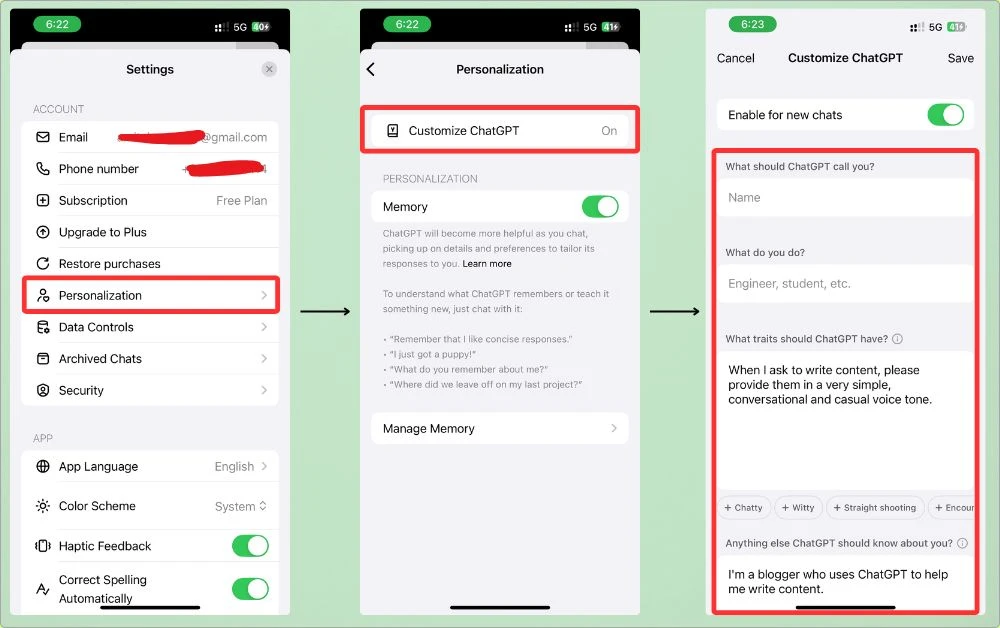
Once set, ChatGPT tailors its responses based on your style and preferences — almost like it remembers who you are.
Step 5: Connect Siri with ChatGPT
With iOS 18, Apple introduced a smoother way to hand off Siri queries to ChatGPT — perfect when Siri says, “Sorry, I can’t help with that.”
To activate:
- Go to Settings → Apple Intelligence & Siri → ChatGPT.
- Now, tap on the Set-Up option next to ChatGPT.
- Tap on Next and then hit the Enable ChatGPT button.
Note: ChatGPT integration is available only on Apple Intelligence-supported devices.
Now, whenever Siri’s stumped, it’ll ask:
“Would you like me to check with ChatGPT?”
You can also say:
“Hey Siri, ask ChatGPT to summarize this article” or
“Hey Siri, get help from ChatGPT about this recipe”
This gives you the best of both worlds — Siri’s convenience with ChatGPT’s intelligence.
Bonus Tip 1: Add ChatGPT to Your Home Screen (No App Needed)
If you don’t want to use the app or prefer the web version, here’s a quick hack:
- Open Safari and go to chat.openai.com
- Tap the Share icon → Add to Home Screen
- Name it something like ChatGPT → Add

Now you’ve got a full-screen, app-like experience — without installing anything.
Bonus Tip 2: Use Back Tap to Open ChatGPT Instantly
Want to summon ChatGPT from anywhere on your iPhone?
- Go to Settings → Accessibility → Touch → Back Tap
- Choose Double Tap or Triple Tap
- Set it to open the ChatGPT app
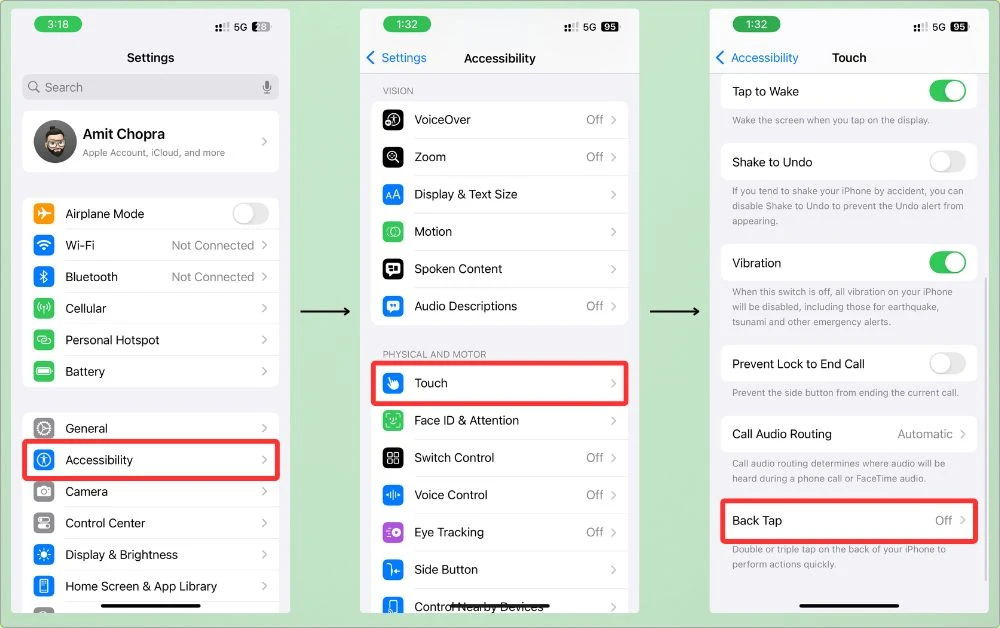
Now just tap the back of your phone twice, and ChatGPT will open immediately.
It’s perfect when inspiration (or confusion) strikes.
Real-Life Use Cases That Actually Help
ChatGPT isn’t just a flashy tech demo anymore.
It’s one of those rare tools that’s actually practical when you know how to use it.
On iPhone, especially, it becomes this all-in-one assistant that adapts to your needs — whether you’re studying, working, creating, or traveling.
Let’s break it down by real-world use cases so you can see how it can really help in everyday life.
1. For Students
No matter if you’re in high school, college, or doing online courses, ChatGPT is your ultimate study buddy.
- Homework Help: Ask it to explain complicated concepts in simple language, solve math step-by-step, or even translate scientific jargon into plain English.
- Study Guides: Upload class notes or copy-paste textbook material, then ask ChatGPT to summarize it, create bullet points, or turn it into flashcards.
- Essay Assistance: Brainstorm ideas, outline your topics, refine thesis statements, or polish your rough drafts. It can even rephrase awkward sentences while keeping your tone.
Try this prompt: I’m struggling to understand [topic]. Can you break it down in simple terms with real-life examples? Also, suggest 3 study tips or memory tricks to help me learn it faster.
2. For Professionals
No matter your field — business, tech, marketing, or freelancing — ChatGPT can quietly boost your productivity behind the scenes.
- Organize Work: Use it to break big tasks into small steps, create to-do lists, or plan out weekly goals. Pair it with the Notes app or Reminders for real traction.
- Better Communication: Write clearer, more professional emails — or tweak your message to sound more persuasive, friendly, or confident, depending on the situation.
- Decision-Making Help: Not sure which way to go on something? Ask it to list pros and cons, simulate outcomes, or help you prep ideas for meetings or presentations.
Try this prompt: Help me write a concise and professional email to [recipient type] about [brief topic]. Keep the tone polite and clear, and include a call to action.
3. For Writers & Content Creators
Writers, bloggers, YouTubers, Instagrammers — this is where ChatGPT really shows off.
- Content Ideas: Ask it for blog titles, video script structures, podcast formats, or trending angles on your niche.
- Social Captions: Upload an image or describe the vibe — it’ll craft captions that are funny, relatable, aesthetic, or emotionally engaging.
- Writing Polish: Improve your grammar, tweak the tone, or clarify your message. You can even paste your own writing and ask it to mimic that same voice.
Try this prompt: Give me 10 creative blog post/video/script ideas around [your niche or theme]. I’m looking for fresh, engaging angles that haven’t been done to death.
By the way, if you’re serious about creating content, don’t miss my roundup of the best AI writing apps out there.
With tools like ChatGPT, you can literally write an entire book—and even sell it.
Sounds wild?
I break it all down for you in this guide.
4. For Travelers
Planning a trip? Exploring a new country?
ChatGPT becomes a multi-tool in your pocket — like a translator, tour guide, and travel planner all in one.
- Real-Time Translation: Just type (or use voice mode), and it’ll translate signs, menus, or conversations instantly. Great for navigating unfamiliar cities.
- Trip Planning: Ask it for personalized itineraries, flight hacks, packing lists based on weather, or even how to avoid tourist traps.
- Hidden Gems Finder: Want recommendations that go beyond Google or TripAdvisor? Ask things like “Where do locals eat in Barcelona?” and get non-touristy options.
Try this prompt: I’m planning a trip to [destination] from [your location] in [month/year]. Suggest a detailed 7-day itinerary including top sights, local food spots, hidden gems, and travel tips.
For travelers, I’ve published some handy guides you might find helpful:
5. For Developers
You don’t have to be a coding wizard to get value here.
ChatGPT is super handy whether you’re learning your first language or debugging something late at night.
- Writing Code: Ask it to generate code snippets in Python, Swift, JavaScript — anything. It’ll also explain what each line does if you’re still learning.
- Debugging: Paste error messages, and ChatGPT will help decode them in plain English, often with suggestions to fix the issue.
- Learn Faster: Use it to generate mini-tutorials or project ideas. Ask it to explain how APIs work or how to build a basic to-do app.
Try this prompt: Explain how to build a [feature/app/project] using [language or framework], with code examples and a step-by-step breakdown. Keep it beginner-friendly.
ChatGPT Prompt Templates That Save You Time
Let’s be real: The quality of ChatGPT’s answers depends heavily on how you ask.
But not everyone has time to learn prompt engineering.
So, I’ve put together a list of battle-tested prompt templates you can copy, paste, and tweak.
Each one is grouped by use case — optimized for iPhone use.
1. For Writing & Blogging
Perfect for creators or marketers.
- Give me 10 blog post ideas about [topic], each with a catchy title and a short summary.
- Rewrite this paragraph to sound more casual/formal/professional.
- Turn this bullet list into a polished LinkedIn post.
- What are the trending topics in [industry] I can write about this week?
I’ve also rounded up my TOP ChatGPT prompts for writing, definitely worth checking out if you’re interested.
2. For Social Media Content
Fast, fresh ideas for Instagram, TikTok, or X (Twitter).
- Write 5 clever Instagram captions for a photo of [describe photo].
- Give me 10 TikTok video ideas based on [niche/trend].
- Write a tweet that summarizes this article in a snappy, engaging way.
- Turn this product feature list into an Instagram carousel copy.
3. For Learning & Study
Perfect for students.
- Explain [topic] like I’m 12 years old.
- Create a 5-question quiz about [topic], including the answers.
- Summarize this text and highlight the key takeaways.
- I’m studying for a test on [subject]. Create a study plan for 7 days.
I’ve also listed 200+ ChatGPT prompts for students, so you can check them out.
4. For Productivity & Work
Get things done without overthinking.
- Turn this note into a formal email to my client.
- Break this big project into actionable tasks with deadlines.
- Give me 3 quick ways to deal with [work problem].
- Help me write a polite follow-up message about [topic].
I also have a list of over 150 ChatGPT prompts for email writing.
If you’d like, check them out too.
5. For Everyday Life
You’d be surprised how helpful ChatGPT can be outside of work, too.
- Plan a healthy weekly grocery list under $60.
- Give me 5 thoughtful gift ideas for a [relationship] who likes [interest].
- What should I pack for a 3-day trip to [destination] in [season]?
- I need a conversation starter for a first date — something light but not boring.
6. For Developers & Techies
Even if you’re a beginner, these prompts are gold.
- Explain this code like I’m new to programming: [paste code].
- Find the bug in this function and fix it: [code].
- Create a simple HTML + CSS landing page for a [describe product].
- Suggest 3 side-project ideas I can build using [language/framework].
Pro Prompt Hack: Add “Ask me follow-up questions before you answer” to get smarter, more tailored results.
Hidden Features Most iPhone Users Don’t Know
Most people use ChatGPT on their iPhones just to type in questions and get answers.
But what they don’t realize is, there are a bunch of extra features that can turn it into a full-blown assistant — if you know where to look.
Here’s a breakdown of the most useful hidden gems that many iPhone users are missing out on, with clear examples so anyone can use them.
1. Voice Mode: Talk to ChatGPT Like a Real Assistant
If you’re tired of typing, the Voice Mode is a game-changer.
Instead of typing out your prompt, just tap the waveform icon in the bottom-right corner of the app and start talking.

ChatGPT will respond out loud like a virtual assistant.
What’s cool is:
- You don’t have to wait for it to finish talking. If you interrupt it by speaking, it’ll stop and listen to you immediately, just like a real conversation.
- It understands a wide range of accents and casual language thanks to OpenAI’s Whisper 3 technology.
- You can even switch between different voice personalities (go to Settings → Voice and choose the one that feels most natural to you).
Real-life example: What are some quick dinner ideas with only 3 ingredients? Ask it while cooking, and get instant ideas hands-free.
2. Image Input: Upload Photos for Instant Explanations
One of the most powerful features of ChatGPT is that it now accepts images as input.
And yes, it’s available for free.
This means you can upload a photo or screenshot, and ChatGPT will analyze it and respond intelligently.
To use it, just tap the “+” icon → Photos.
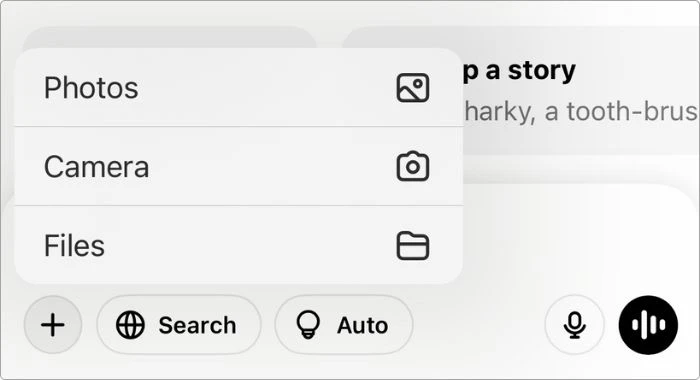
Here are a few creative ways to use it:
- Snap a picture of handwritten notes → ask it to summarize or type them out for you.
- Take a screenshot of a chart or graph → ask for a plain-language explanation.
- Upload a menu in a foreign language while traveling → get it translated, plus ask, “What should I try?”
- Share a math problem or diagram → ask for a step-by-step solution.
3. Memory: ChatGPT Now Remembers Things About You
Yes, ChatGPT’s memory is officially live on iOS.
And it makes the experience feel much more personal and helpful.
With memory turned on, ChatGPT can remember:
- Your name
- Your writing preferences (e.g., casual, professional, friendly)
- Your past activity or frequently mentioned topics
It won’t remember everything you say.
Only the important parts, and you’ll be notified whenever something is saved.
You can always view, delete, or reset your memory anytime.
To check or manage memory:
- Go to Settings → Personalization → Memory
- From here, you can see what it remembers and turn the memory on or off.
Real-life example: If you often ask it to write in a specific tone (like “write casually, like I’m texting a friend”), it will remember and automatically use that style moving forward.
However, as memory usage increases, it takes up more storage.
So, here’s how you can free up space on your iPhone without removing any apps.
4. Explore and Use Custom GPTs
Custom GPTs are like specialized versions of ChatGPT — built to do one job really well.
Think of them as pre-trained assistants focused on a niche like writing, fitness, travel planning, coding, and more.
To access them:
- Tap the Menu → Explore GPTs.
- Browse and favorite the ones that match your interests
- Use them just like regular ChatGPT but with added tools, behavior, and custom knowledge

Some examples of popular Custom GPTs:
- Writing Coach – helps you improve your writing
- Travel Buddy – helps plan trips and itineraries
- Fitness Trainer – gives you workouts and nutrition plans
- Language Tutor – teaches you conversational phrases in your target language
Real-life example: Use the Travel Genius GPT to build a full itinerary for Tokyo, including what to pack, when to visit, and how to get around.
5. Share ChatGPT Conversations with a Link
Ever had an amazing ChatGPT conversation that you wanted to show someone else?
Now, you can easily share any chat as a clean, viewable link.
Here’s how:
- Tap ChatGPT at the top of any conversation
- Select Share → Share Link
- You’ll get a link that opens a read-only version of the conversation, which anyone can view (no account needed)
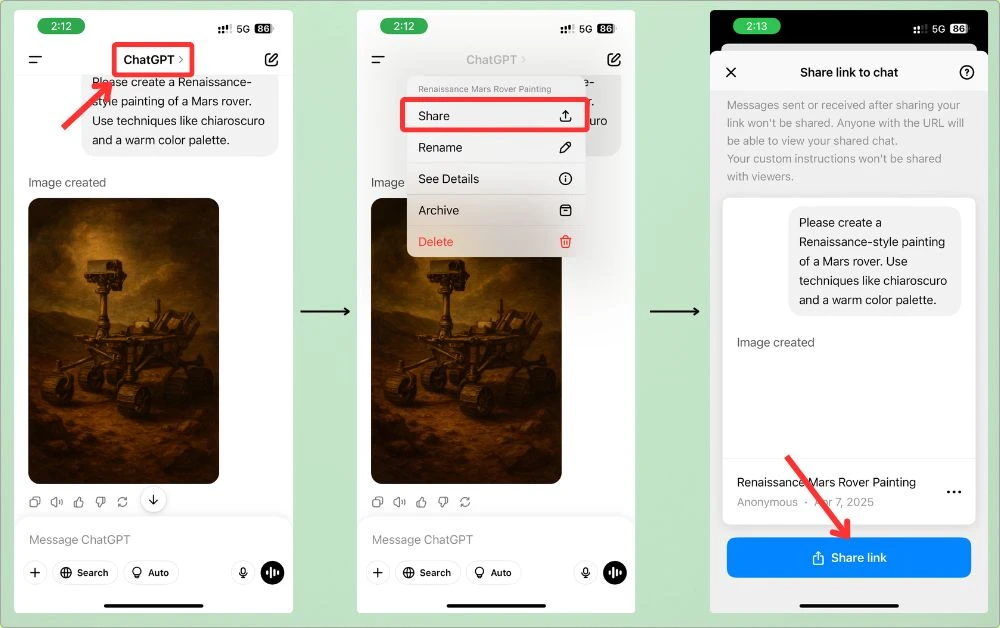
6. Use iOS Shortcuts to Automate Tasks with ChatGPT
If you like automating things on your iPhone, ChatGPT integrates nicely with the Shortcuts app.
You can:
- Send text to ChatGPT and get responses right in your notifications
- Create Siri voice commands that trigger custom prompts
- Save results to Notes, Calendar, or Reminders
Make It Work Smarter With iOS Features
Your iPhone is packed with powerful features like Siri, Shortcuts, Focus Modes, and widgets.
When you combine those with ChatGPT, it becomes way more than just a chatbot.
It turns into a personal productivity powerhouse.
Here’s how to make them work together:
1. Use Siri Shortcuts to Run ChatGPT Prompts Instantly
With the Shortcuts app on iOS 18, you can create custom voice or tap workflows that trigger ChatGPT in seconds — either through the ChatGPT app, a web request, or API integration.
Here’s how to set it up:
- Open the Shortcuts app → Tap the “+” icon
- Add a Text action and enter your prompt. For example: “Give me a motivational quote for today.”
- Add the ChatGPT action:
- If you’re using the ChatGPT app, choose Open App or a specific chat (if pinned).
- If using API/web integration, add a Get Contents of URL action or connect it via a webhook.
- Optional: Add a Show Result action to display ChatGPT’s response (if using API).
- Name your shortcut something simple, like Daily Quote
- Now say: Hey Siri, Daily Quote
Example ideas:
- Summarize today’s to-do list
- Idea for a tweet
- Quick blog title suggestions
- Explain this coding error I pasted
Pro Tip: If you’re using the official ChatGPT iOS app (by OpenAI), you can also trigger custom GPTs directly by using a URL scheme or setting them up as pinned chats and linking to them in your Shortcut.
2. Add a ChatGPT Widget to Your Home Screen
Want to access ChatGPT faster than opening the app?
Here’s how to add it as a widget:
- Long press your iPhone home screen → Tap the “+”
- Search for ChatGPT in the widget list
- Choose the size and tap Add Widget
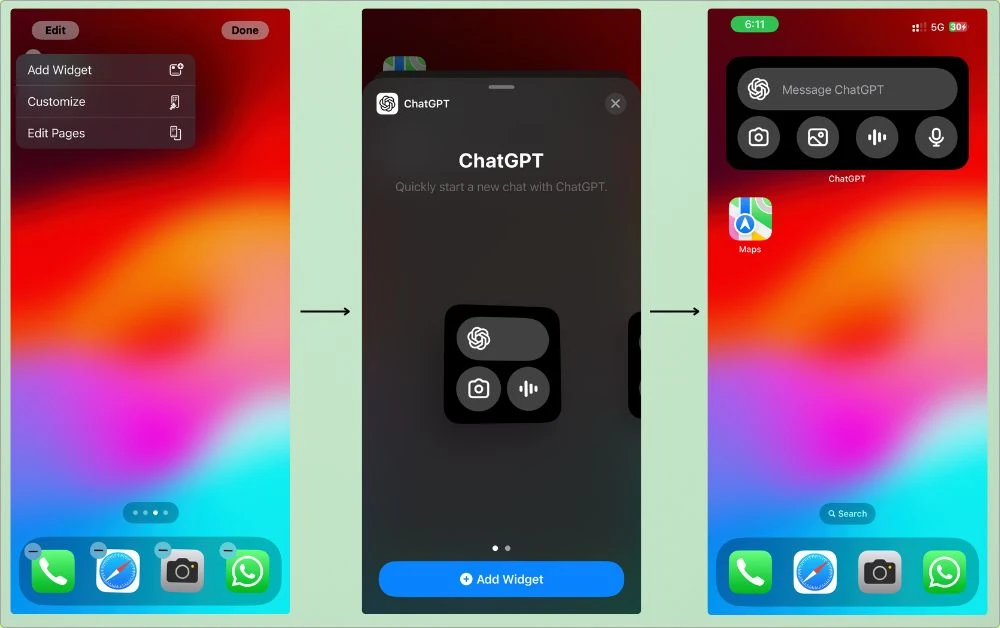
Once added, you can tap the widget and jump directly into your most recent chat or a fresh conversation.
3. Use Share Sheet Integration for Instant AI Help
Whenever you’re reading something — in Safari, Notes, or even Mail — you can quickly send that content to ChatGPT via the iOS Share Sheet.
Here’s how:
- Highlight any text on your iPhone
- Tap Share
- If ChatGPT is installed, you’ll see it in the app suggestions
- Tap it, and the selected text will appear in the ChatGPT app for follow-up
Example: Highlight a confusing paragraph from an article → share it to ChatGPT → ask “Can you explain this more simply?”
This works great for reading research papers, translating text, or simplifying legal or technical language on the fly.
4. Use ChatGPT During Focus or Work Modes
Pair ChatGPT with your Focus Mode to stay productive.
Here’s how:
- Create a Work Focus Mode in iPhone Settings
- Only allow apps like Notes, Safari, Reminders, and ChatGPT
- Turn off notifications that cause distraction
- Use ChatGPT to brainstorm, outline, or organize thoughts during deep work sessions
It’s a great way to treat ChatGPT as your quiet thinking partner — always there when you need ideas, without pulling you into distractions.
5. Combine ChatGPT with Reminders & Notes
Want a smarter, AI-powered planning system on your iPhone?
Here’s how you can use ChatGPT to supercharge Reminders and Notes:
5.1 For Reminders:
- Ask ChatGPT: Plan my day and create a to-do list based on these meetings.
- Copy the output directly into your Reminders app,
OR
- Create a Shortcut that auto-adds ChatGPT-generated tasks into Reminders using “Add New Reminder” action.
5.2 For Notes:
Ask ChatGPT to:
- Clean up a messy brainstorm
- Organize scattered bullet points
- Write a meeting summary from raw notes
- Paste the result into the Notes app — or use Shortcuts to automate it.
Common Problems, Fixed (Fast)
Even though ChatGPT on an iPhone is a powerful tool, it’s not perfect.
You might run into bugs, delays, or even odd replies.
But don’t worry.
Most of these issues have quick fixes.
This section will help you troubleshoot the most common problems users face.
1. The App Is Crashing or Freezing
Sometimes, the ChatGPT app may freeze, crash on launch, or get stuck during a conversation.
Here’s what to do:
Quick Fixes:
- Force close the app: Swipe up from the bottom of your screen, then swipe ChatGPT off.
- Restart your iPhone: Many glitches fix themselves after a simple reboot.
- Update the app: Open the App Store → tap your profile → scroll down to see if an update is available.
- Reinstall the app: Long-press the icon → tap Remove App → reinstall it from the App Store. Your chats are backed up, so you won’t lose anything important.
Tip: If the problem started after a new iOS or app update, chances are it’s temporary — OpenAI usually patches bugs quickly.
2. It’s Too Slow or Doesn’t Respond
Sometimes, ChatGPT can feel sluggish, especially during peak hours or on a slow connection.
Quick Fixes:
- Check your internet connection: Switch between Wi-Fi and mobile data to see if one is faster.
- Close background apps: Freeing up memory can help ChatGPT respond faster.
- Try voice mode: Responses in voice mode tend to feel more real-time.
- Wait a few minutes: High traffic on OpenAI’s servers can temporarily slow things down — it usually clears up quickly.
3. It Gave a Totally Wrong Answer (aka “AI Hallucinations”)
Sometimes, ChatGPT can sound confident but still give you inaccurate or made-up info — this is called an AI hallucination.
What to Do:
- Double-check facts elsewhere. Use trusted sources like Google, Wikipedia, or specialized sites.
- Give clearer prompts. Vague inputs can confuse the model. Try: “Explain this like I’m a beginner” or “List sources if possible.”
- Ask it to verify itself. You can say: “Can you fact-check that answer?” or “Give sources or links.” GPT-4 often rechecks its own output when asked.
- Remember: ChatGPT is smart, but not always right. Treat it as an assistant, not an authority.
4. Worried About Privacy or Saved Conversations?
Many users ask: Is ChatGPT storing all of my chats?
Here’s the deal:
- Yes, your conversations are saved so you can access them later.
- No, ChatGPT doesn’t use your chats to retrain models if you turn that option off.
How to manage your data:
- Open ChatGPT → Settings → Data Controls
- Tap Chat History & Training
- You can disable the Improve the model for everyone toggle or delete all your chats.
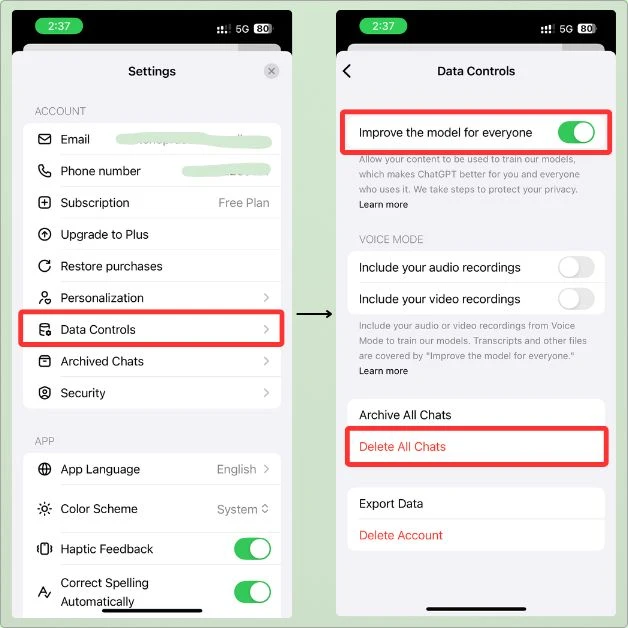
5. ChatGPT Is Draining My Battery
Using ChatGPT — especially with voice or image input — can be a little demanding on your phone’s battery.
Battery-saving tips:
- Use Dark Mode (less strain on OLED screens).
- Avoid background usage: Close the app when not in use.
- If you’re using voice or long sessions, plug in or keep a power bank handy.
- Lower screen brightness and background refresh for other apps to reduce the overall drain.
In short, ChatGPT won’t kill your battery in short bursts.
But for power users, these small tweaks help a lot.
Future Updates & Features to Watch For
OpenAI is pushing hard to make ChatGPT feel more like a true AI assistant, not just a chat interface.
And that means more features, smarter behavior, and even deeper integration into your iPhone’s ecosystem.
Here’s what we know (and what to expect soon):
1. More Personalized ChatGPT with Memory (Full Rollout)
While memory started rolling out in early 2024, it’s getting wider and smarter in 2025.
- What it does: ChatGPT remembers your name, preferences, past tasks, and writing style.
- Why it matters: You’ll spend less time repeating yourself and more time getting tailored results.
- What’s next: Expect better controls over memory, like seeing what ChatGPT remembers and toggling things on/off per topic.
2. Smarter, More Human Voice Conversations (GPT-4o & Beyond)
OpenAI is currently rolling out GPT-4o (Omni) — a faster, more responsive model that blends voice, image, and text seamlessly.
- Natural back-and-forth conversations — with interruptions, tone shifts, and real-time context.
- Works more like a real assistant — you can speak casually and get smart answers on the go.
- Expect improvements in response time, voice personalities, and offline access in future updates.
The goal? Make ChatGPT feel more like talking to a helpful friend than typing into a bot.
3. More Visual Features with Image Input & Generation
Currently, you can upload images and get help understanding them — even on the free plan (thanks to GPT-4o).
What’s coming next:
- Better visual reasoning: Explain charts, homework, documents, or screenshots in detail.
- Integrated AI drawing tools: Sketch something, and ChatGPT can help complete it.
- On-device OCR (text from image): Faster recognition of handwritten or printed text from camera inputs.
Whether you’re a student, traveler, or creative, the camera + ChatGPT combo is about to become a game-changer.
4. Deeper iOS Integration Is on the Way
Things are quietly shifting.
OpenAI and Apple haven’t officially announced anything, but the signs are everywhere.
The ChatGPT app already supports Siri Shortcuts.
And it looks like that’s just the beginning.
Expect more system-level integration soon, including:
4.1 Expanded Shortcuts Support
Automate full workflows using GPT, like:
- Custom prompt sequences
- Daily content routines
- Hands-free replies for emails or messages
4.2 Lock Screen & Widget Interactions
Imagine seeing a summary of:
- Your day
- Content ideas
- Or quick prompts
Without even unlocking your phone.
That’s what’s being worked on behind the scenes.
4.3 Tighter Siri support
Apple’s been rebuilding Siri from the ground up.
OpenAI may end up powering some of the new voice smarts — or at least influencing how natural Siri becomes.
And that’s not all.
ChatGPT could soon work inside core Apple apps, making it feel less like a separate tool and more like part of your iPhone:
- Messages: Auto-reply suggestions, tone adjustments, or smart rewording for long texts
- Mail: Draft generation, proofreading, and even full reply assistance
- Calendar: Suggesting times, summarizing events, or rewording meeting invites
Apple has been gradually allowing more third-party AI into its ecosystem.
And OpenAI is right at the center of that move.
What used to require separate apps might soon be available system-wide, built right into the iPhone experience.
5. ChatGPT for Apple Watch (Still in the Works)
While there’s no official standalone ChatGPT app for Apple Watch yet, OpenAI might eventually bring it — or allow tighter integration through Siri or Shortcuts.
What it could look like:
- Quick voice chats from your wrist
- Asking for summaries, directions, or calendar events
- Instant translations or reminders on the go
Until then, you can still use Siri Shortcuts to trigger ChatGPT prompts from your Watch — it’s not perfect, but it’s a start.
FAQs
1. Is ChatGPT free to use on an iPhone?
Yes. The official ChatGPT app is free to download and use. With the free plan, you get access to GPT-4o, voice mode, and image understanding. But if you want even more powerful features like faster responses, Image generation, or advanced reasoning, there’s a paid plan too.
2. What’s the difference between the free and Plus plans?
The free plan is great for everyday tasks, chatting, and quick help. The Plus plan ($20/month) gives you:
→ Access to GPT-4 Turbo (faster + smarter)
→ More memory and better context
→ Advanced voice mode
→ Image generation and file uploads
→ Limited access to Sora video generation
→ Priority access during busy times
3. Can I use ChatGPT instead of Siri?
Kind of. You can’t replace Siri completely, but you can connect Siri to ChatGPT using Shortcuts or hand-off questions.
4. Does ChatGPT work offline on an iPhone?
Not yet. You need an internet connection (Wi-Fi or data) for ChatGPT to work. Offline mode has been teased by Apple for the future, though, especially for voice conversations.
5. Can I talk to ChatGPT like a real assistant?
Yes. Just tap the waveform icon and start speaking. ChatGPT responds with natural voice replies. You can even interrupt it while it’s talking and change the topic mid-conversation. It’s shockingly fluid.
6. Can ChatGPT remember things about me on my iPhone?
Yes, if the memory is turned on. It can remember your name, preferences, or the kind of responses you like. You can manage or delete memory anytime in Settings > Personalization.
7. Is it safe to use ChatGPT on my phone?
It’s as safe as using any other major app. OpenAI doesn’t use your personal chats to train the model by default, and you can turn off data sharing in settings. Still, don’t share sensitive info like passwords, just to be smart.
8. Can I use ChatGPT with other iPhone apps?
Yes — especially with features like:
→ Share Sheet (send info from Safari, Notes, etc., to ChatGPT)
→ Shortcuts app (set up quick prompts or actions)
→ Back Tap (open ChatGPT with a double tap on the back of your phone)
9. Can I use ChatGPT for school or work?
Absolutely. Students use it for studying, summaries, and writing help. Professionals use it for emails, brainstorming, scheduling, and more.
My Final Take
Using ChatGPT on an iPhone isn’t just convenient.
It’s powerful, practical, and surprisingly fun.
But like any tool, its real power depends on how you use it.
The more you explore, the more valuable it becomes.
So take the tips, tricks, and hidden gems from this guide — and make ChatGPT your own.
The future of the iPhone isn’t just about smarter hardware.
It’s about smarter conversations.
And this is just the beginning.
That wraps it up for now.
If there’s anything else you’d like me to explore or share, just let me know.

